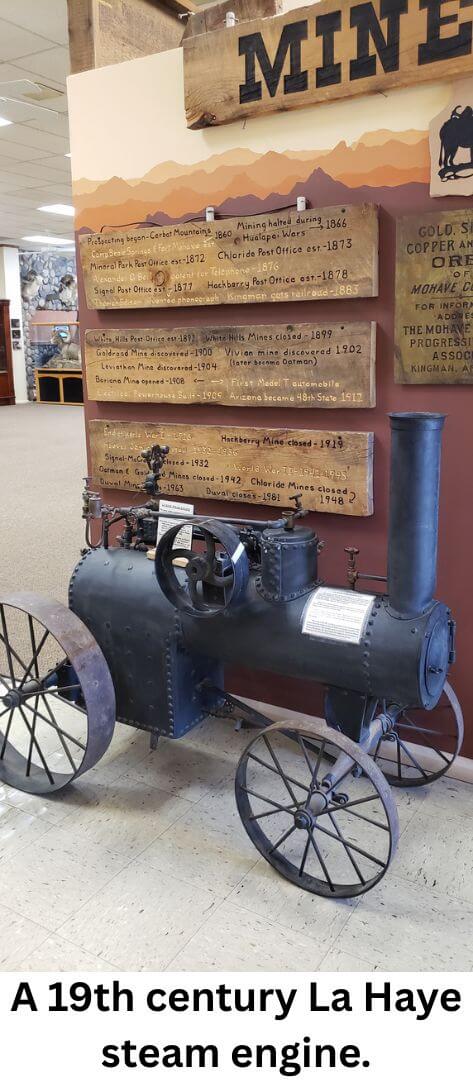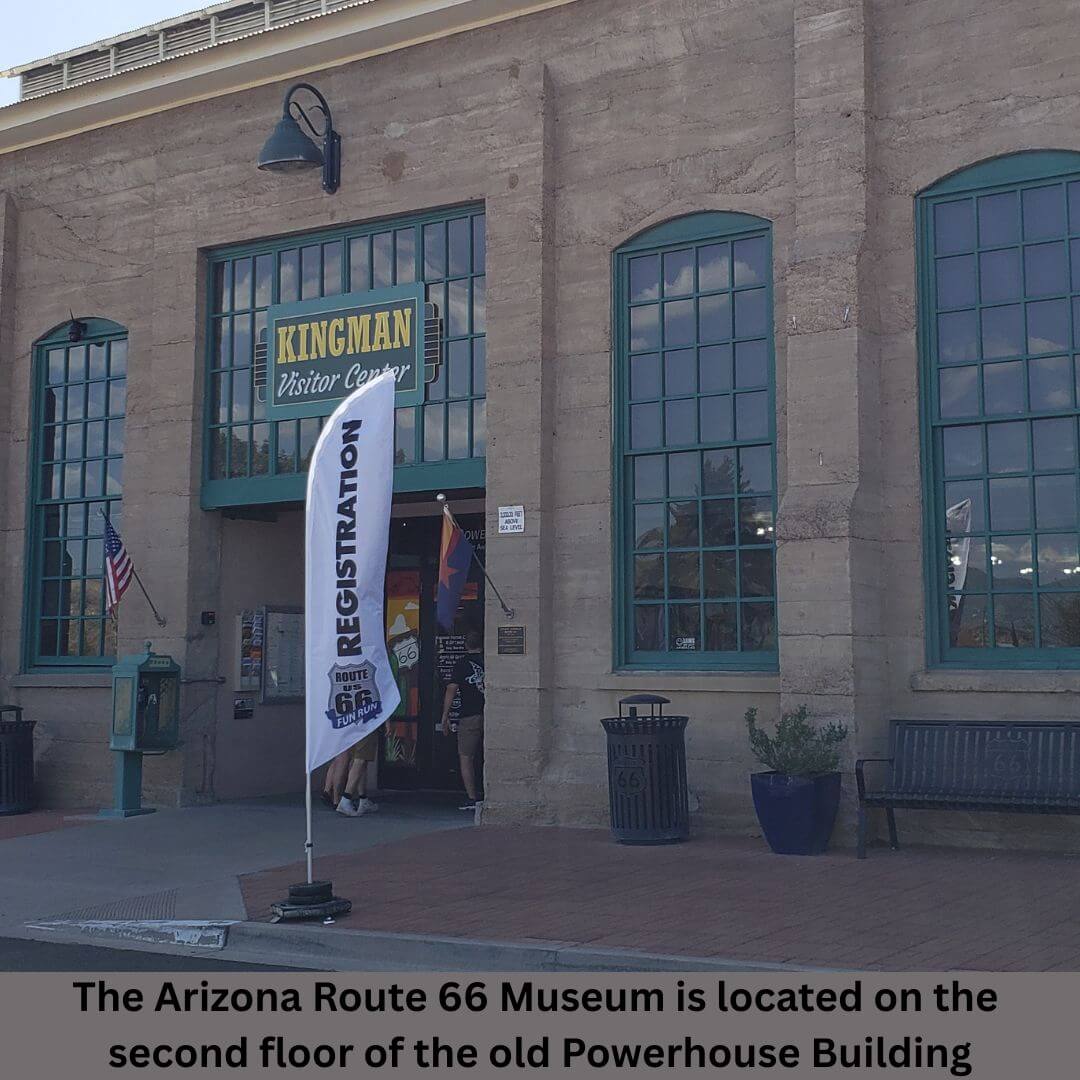The historic Arizona Route 66 Museum, the Mohave Museum of History & Arts, and the Bonelli House are three museums under the Mohave County Historical Society’s umbrella. They are all in close proximity to each other within the historic downtown district of Kingman, Arizona. One admission fee is good for all three museums (www.mohavemuseum.org).
Arizona Route 66 Museum
The ‘Powerhouse’ Arizona Route 66 Museum is located on the second floor of the old Powerhouse Building, which also serves as a visitor center and gift shop. The Powerhouse is Arizona’s oldest known reinforced concrete building, which generated electricity from 1909 to 1938. It was renovated to its current use in 1997. Thousands of visitors from around the world travel on historic Route 66 for adventure, nostalgia, history, and education.
 The museum displays include vehicles from pioneer wagons to electric cars, photographs, and artifacts covering the history of Route 66, known as “The Mother Road,” from the wagon trail to the present day. An exhibit about twenty-seven local mines includes an open mine shaft and mine tools. A mineral display features local gold ores, quartz and chalcedony, chrysocolla, and galena.
The museum displays include vehicles from pioneer wagons to electric cars, photographs, and artifacts covering the history of Route 66, known as “The Mother Road,” from the wagon trail to the present day. An exhibit about twenty-seven local mines includes an open mine shaft and mine tools. A mineral display features local gold ores, quartz and chalcedony, chrysocolla, and galena.
Visitors can watch a one-hour movie at the small theater and learn about the colorful history of the “heart” of Route 66, which includes the towns of Seligman and Kingman. The Route 66 Museum is open daily from 9 am to 4 pm.
Across the street is the Locomotive Park, where Steam Engine #3759 is stationed. Nearby is the Kingman Railroad Museum.
Mohave Museum of History & Arts
For an in-depth understanding of the local history, visit the Mohave Museum of History & Arts, founded in 1961. The museum shares the history of “The Forgotten Ones” and Mohave, Hualapai, Chemehuevi, and Paiute Indian tribes, with pottery, dioramas, manos-and-metate displays, and arrowheads.
 A great exhibit, “Mines & Ghost Towns,” gives details about the local mining. It features a 19th-century La Haye steam engine invented by French Gustave Pierre Trouvé, and a miner’s cabin diorama with a gold-catching dry washer. A nice mineral collection from the Hackberry Mine, the first silver mine in the county, shares the story of its discovery and development in the 1870s by four miners, including W.B. Widenour, who found the mineral outcropping near a hackberry tree. Gold and copper were also mined there, and a five-stamp mill was built there. Sadly, by 1919, the ore veins dwindled and the mines closed.
A great exhibit, “Mines & Ghost Towns,” gives details about the local mining. It features a 19th-century La Haye steam engine invented by French Gustave Pierre Trouvé, and a miner’s cabin diorama with a gold-catching dry washer. A nice mineral collection from the Hackberry Mine, the first silver mine in the county, shares the story of its discovery and development in the 1870s by four miners, including W.B. Widenour, who found the mineral outcropping near a hackberry tree. Gold and copper were also mined there, and a five-stamp mill was built there. Sadly, by 1919, the ore veins dwindled and the mines closed.
I loved the small, carefully curated displays of agate and honey onyx from North Stockton Hill, as well as the silver, gold ore, and hematite specimens from the White Hills Mine, which were discovered in 1892. Unfortunately, that mine was sold off after a 1899 flash flood that completely filled the shafts. Tungsten and molybdenum were discovered at the Boriana mine, which opened in 1908 but closed in 1962. A case full of gold ore samples from the Goldroad and Oatman mines, and another case featuring crucibles for melting bullion samples are also on display.
A photographic exhibit of the mines in Oatman includes the Tom Reed Mine, discovered in 1908. By 1925, it paid over $2,000.000 ($50,000.000 today) in dividends to its shareholders. The mine had a ten-stamp mill. It closed in 1942 when the government closed all gold mines due to the war effort.
Another case is filled with minerals from Mineral Park. The mine is named after its park-like setting of cedar trees in a mineral-rich basin at the foot of Ithaca Peak. Silver was discovered in 1870, and by 1877, there were over 700 permanent residents with doctors, lawyers, a school, a hotel, shops, saloons, and opium dens. By the mid-1880s, the rich silver ore began to play out, and prices dropped. In 1902, an extremely large and rich body of ore was discovered in Mineral Park by a woman miner, Mrs. Cordelia Kay, who reportedly did everything at the mine – cut the fuse, bit the cap, tamped the powder, and returned into the smoke to see the results. She was very successful mining turquoise, especially at her Ostrich Copper Mine. A beautiful photo of her, sitting erect on her horse while inspecting the mines, is on display.
 A series of cases at this spacious museum tell the Arizona geology story and its minerals, including jasper, chrysocolla, copper, onyx, silver, tremolite, and, of course, beautiful large specimens of turquoise. Another case displays Kingman turquoise natural specimens, cabochons, and jewelry. One last unusual exhibit is the Hall of Presidents, featuring portrait photographs of all our Presidents.
A series of cases at this spacious museum tell the Arizona geology story and its minerals, including jasper, chrysocolla, copper, onyx, silver, tremolite, and, of course, beautiful large specimens of turquoise. Another case displays Kingman turquoise natural specimens, cabochons, and jewelry. One last unusual exhibit is the Hall of Presidents, featuring portrait photographs of all our Presidents.
The museum is open Tuesday-Saturday, 9 am to 4 pm.
Bonelli House Museum
The third museum is the Bonelli House, a territorial-style home built in 1894 by George A. Bonelli as a gift for his bride, Effie Ellen Tarr, whom he married in 1895. Almost everything was lost in a 1915 fire; the few surviving items are now displayed in the museum. It is open for guided tours Tuesday through Friday, 11 am to 3 pm.
The Mohave County Gemstoners Gem & Mineral Show
The Mohave County Gemstoners Gem & Mineral Show will be held in Kingman on Saturday, May 3 and Sunday, May 4, 2025 at the Mohave County Fairgrounds at 2600 Fairgrounds Blvd. There is free admission to the show, but donations are always welcome. There will be 25 show dealers with gemstones, minerals, jewelry, fossils, rocks, and woodwork; also, kids’ activities, raffles, hourly door prize drawings, and food vendors. The show is sponsored by the Mohave County Gemstoners (MCG) www.gemstoners.org.
You can also read my other article Mohave County Gemstoners Gem & Mineral Show in Kingman, Arizona, in which I describe several nearby attractions — the Skywalk, Hoover Dam, Laughlin, Davis Dam, Grapevine Canyon, Havasupai Falls, and the historic mining towns of Chloride and Oatman.
Helen Serras-Herman, a 2003 National Lapidary Hall of Fame inductee, is an acclaimed gem sculptor and FGA graduate gemologist with over 40 years of experience in unique gem sculpture and jewelry art. See her work at www.gemartcenter.com and her business Facebook page at Gem Art Center/Helen Serras-Herman. Helen has published over 70 articles for Xpo Press and the EZ Guides. All photos © Helen Serras-Herman




